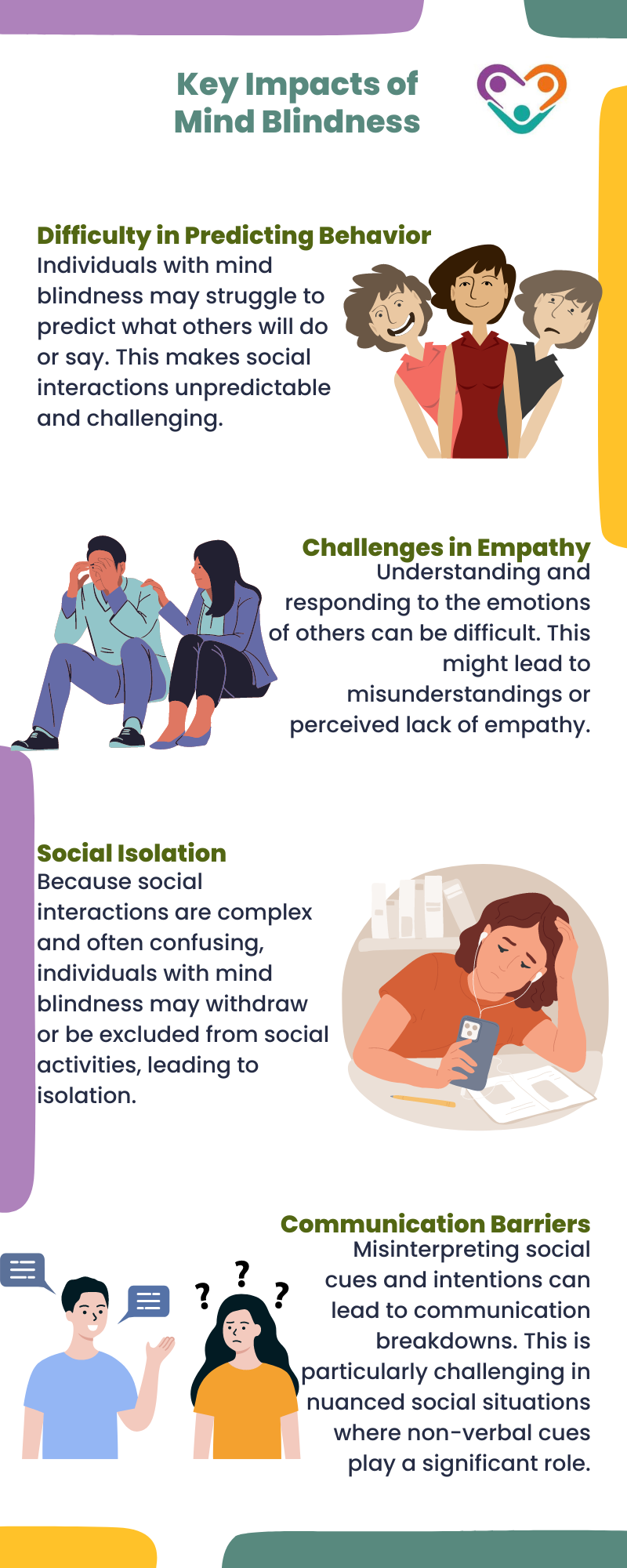Autism spectrum disorder is a complex developmental condition that affects how a person communicates, interacts with others, and behaves.
One of the lesser-known aspects of autism is “mind blindness.” Also referred to as Theory of Mind (ToM) deficits, mind blindness describes the difficulty individuals with autism have in understanding and interpreting the thoughts, feelings, and intentions of others.
But what exactly is mind blindness? And what is its impact on individuals with autism? Let’s take a deeper look.

Understanding Theory of Mind
Theory of Mind (ToM) is the ability to attribute mental states – beliefs, intents, desires, emotions, knowledge, etc. – to oneself and others. It also involves understanding that others have mental states that are different from one’s own. This cognitive skill is crucial for everyday social interactions, as it helps individuals predict and interpret the behavior of others.
ToM typically develops in early childhood. Around the age of 4 or 5, most children begin to understand that other people have thoughts and feelings different from their own. For instance, they recognize that someone else might not know something they do or that another person can hold a false belief about the world.
What is Mind Blindness?
Meanwhile, mind blindness refers to the difficulty or inability to understand that other people have their own thoughts, beliefs, desires, and intentions that are different from one’s own.
This concept was first introduced by researchers Simon Baron-Cohen, Alan M. Leslie, and Uta Frith in their groundbreaking 1985 study, “Does the Autistic Child Have a ‘Theory of Mind’?“
In their study, Baron-Cohen and colleagues used the Sally-Anne test, a classic ToM assessment. In this test, children watch a scenario involving two dolls, Sally and Anne. Sally places a marble in a basket and leaves the room. Anne then moves the marble to a different location.
The children are then asked where Sally will look for the marble when she returns. Typically developing children understand that Sally will look in the basket where she last saw the marble, demonstrating an understanding of false belief. However, children with autism often fail this test, indicating a difficulty in attributing false beliefs to others.
The Impact of Mind Blindness
Mind blindness significantly affects social interactions and relationships for individuals with autism. Some of the key impacts include:

Research and Studies on Mind Blindness
There have been numerous studies that were explored regarding mind blindness and its implications. Here are a few key pieces of research:
Baron-Cohen’s Studies
Simon Baron-Cohen has been a leading figure in the study of ToM and autism. His 1995 book, “Mindblindness: An Essay on Autism and Theory of Mind,” provides an in-depth analysis of ToM deficits in autism. Baron-Cohen’s work emphasizes that while mind blindness is a core aspect of autism, it is not the sole defining feature.
Leslie and Frith’s Research
Alan M. Leslie and Uta Frith have also made significant contributions. In their early work, they proposed that ToM deficits could explain many of the social and communication difficulties seen in autism. Their research supports the idea that mind blindness is a central cognitive feature of autism.
Neuroimaging Studies
Advances in neuroimaging have allowed researchers to study the brain regions involved in ToM. Studies using functional MRI (fMRI) have shown that individuals with autism often exhibit atypical activation in the brain regions associated with ToM, such as the medial prefrontal cortex and the temporoparietal junction. These findings suggest that neural differences contribute to mind blindness.
Intervention Studies
Intervention studies aim to improve ToM abilities in individuals with autism. For instance, social skills training programs often include components designed to enhance ToM. Research indicates that these interventions can lead to improvements in understanding and predicting social interactions, although they may not entirely eliminate mind blindness.
Living with Mind Blindness
Understanding mind blindness is crucial for providing support to individuals with autism. Here are some strategies that can help:
- Clear and direct communication– Using clear, concrete language and avoiding idioms or abstract expressions can help individuals with mind blindness understand better.
- Social stories– These are short, descriptive stories that explain social situations and expected behaviors. They can help individuals with autism navigate social interactions more effectively.
- Visual supports– Visual aids, such as charts and diagrams, can help in understanding social cues and expectations.
- Modeling and role-playing– Demonstrating and practicing social interactions can provide valuable learning experiences.
- Patience and understanding– Recognizing that mind blindness is a cognitive difference and not a deliberate choice can foster patience and empathy from others.
Mind blindness, or Theory of Mind deficits, is a significant aspect of autism that affects social understanding and interactions, and in some cases, it can even impact memory. While it presents challenges, increased awareness and understanding can lead to better support and interventions.
Research continues to shed light on the complexities of mind blindness, offering hope for more effective strategies to help individuals with autism navigate the social world. By fostering empathy and creating supportive environments, we can help individuals with autism lead fulfilling and connected lives.
Sources:
https://www.parents.com/what-is-mind-blindness-7509876
https://getgoally.com/blog/neurodiversopedia/mind-blindness
https://www.thetransmitter.org/spectrum/mind-blindness-affects-moral-reasoning-in-autism
https://kennethrobersonphd.com/mindblindness-in-adults-with-autism-spectrum-disorder




